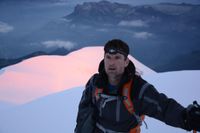

Merino is considered something of a magical material in the outdoor world. Used in everything from the best base layers, hiking socks, and technical tops on the market to the lining of good-quality winter gloves and hats, it feels luxuriously soft next to your skin. It has almost mystical powers when it comes to temperature regulation.
When you look at the specs of a garment containing (or made entirely from) merino, you might see the material listed next to a GSM number. This acronym stands for ‘grams per square metre’ and relates to the thickness of the fabric (not the weight of the entire garment, although the higher the GSM, obviously the heavier the piece of clothing will be).
But what is the best GSM to go for? To properly understand that – and to appreciate the fact that the perfect number might change according to where you are, what you’re doing and what time of year you’re doing it – we need to take a few steps backwards.
What is merino, exactly?
Merino is an exceptionally fine and soft wool derived from a hardy breed of sheep called – wait for it – the merino, which is indigenous to the Atlas Mountains in North Africa, where it evolved to cope with temperatures that fluctuate wildly between hot and cold.
The breed was cultivated for its wool in Spain in the Middle Ages when the material was so highly valued that exporting the animals was forbidden by law – a law that could see you executed if you broke it.
Spanish wool’, as it was known, became valuable, and inevitably, word about this golden fleece got out. Spanish monarchs gifted a few of the animals to other courts around Europe, and over time, they were exported to newly discovered lands. Now, there are populations of merino sheep everywhere, from South Africa and America to Australia and New Zealand.
The hardy sheep seem to do exceptionally well in the antipodes, where clever companies like the Kiwi brand Icebreaker [external link] pioneered merino wool in high-performing technical garments designed for use in the outdoors during the 1990s.
Get all the latest news, reviews, deals and buying guides on gorgeous tech, home and active products from the T3 experts
And what is so good about merino wool?

Companies like Smartwool make a huge range of merino-based outdoor apparel
The magic of merino wool is its ability to help you regulate your temperature, no matter what the weather is doing: the material supplies excellent thermal warmth when it’s chilly outside (even when it gets wet), and yet the same garment can also keep you cool when the weather is hot. Those sheep are smarter than they look…
But wait, there’s more. Much more. Unlike most kinds of wool, merino doesn’t feel itchy or scratchy next to your skin (we won’t go into too much boring detail about why, but basically, its fibres are only 16.5 to 24 microns across, about half the thickness of most wool fibres, so instead of sticking into your skin and prickling, they just bend and feel super soft). These same fibres also hold lots of air, which is why the material packs so much insulation power.
Being a natural fabric, merino lets your body breathe beautifully, but when you work up a sweat, the hygroscopic wool fibres absorb moisture and then wick it away from your body through a process of evaporative cooling, which stops you from overheating.
The fantastic fabric even boasts naturally occurring protein that breaks down the bacteria in your sweat responsible for making your clothes stink. This means you can wear Merino garments multiple times without washing them (or losing friends), which is incredibly useful when you’re carrying all your own kit on a multiday outdoor adventure and trying to keep the weight of your backpack and the bulk of your kit down, whether you’re hut hiking, backpack camping, bikepacking or fastpacking.
In terms of the GSM, though, the higher the number, the thicker the Merino garment will be and the more insulating power it will pack. This is a fantastic advantage when you’re looking for a versatile base layer or a technical top that will perform in an environment with variable temperatures (cool in the morning and evening but warm during the day, for example).
Are there any drawbacks to merino?
As magnificent as it is, merino does, of course, have some downsides. One is that if it gets wet, it takes much longer than a synthetic garment to dry (although it will keep working when it’s damp).
The other is that, sadly, used on its own, merino usually won’t last very long – thin merino clothing with a low GSM especially will quite quickly develop holes and/or lose its shape.
Garments with higher GSM are tougher and will last for longer, but for real robustness and longevity, look for models where the merino has been mixed with another material like polypropylene and/or elastane. This is especially important when you’re looking at items of clothing that take a lot of punishment, such as hiking socks.
OK, so what GSM of Merino is the best, then?

The Finisterre Eddy base layer works well from the beach to the peaks
The weight of your Merino base layer really depends on what you’re planning to do and in what kind of conditions. It also varies according to the garment in question and the job it needs to perform because selecting the best GSM for Merino clothing doesn’t just come down to temperature control (although that is a big part of it).
If you’re going on a spring or autumn hike or bike ride or doing something energetic like hill hiking, running or skiing in winter, it’s a good idea to adopt a layering system, starting with a good cold-weather base layer and lightweight Merino is the ideal material for these garments.
An example of the perfect piece to use is the excellent Helly Hansen LIFA Merino Lightweight Half Zip Baselayer. This high-performing top is made with 160gsm merino, which makes it the ideal weight and thickness to wear as your underlayer.
Similarly, for trail running escapades, summer day walks and other fair-weather outings, a technical T-shirt made from lightweight merino is absolutely ideal. If conditions get chillier or wetter, you can layer up with a good fleece and/or a weatherproof jacket, and the Merino base layer will continue to do its job underneath.

In colder environments, especially if you’re climbing or camping or doing anything that involves periods of standing still, and when carrying weight is less of an issue, then a thicker mid-layer-style garment is better suited to the task.
A top such as the Quantum III Long Sleeve Zip Jacket from Icebreaker [retailer link], which is constructed with 260 GSM Merino, will keep you toasty and warm. As temperatures get lower still, then you might need to increase the GSM of your outer layer to something on par with the Smartwool Intraknit Active Full Zip Jacket or the Smartwool Smartsoft jacket (both retailer links).
Garments with a GSM of 300 or more can be described as heavyweight (although that doesn’t necessarily mean the entire piece of clothing will be heavy, it’s just that it’s constructed with thicker, more densely woven wool). It’s helpful to break it down into three categories, like so:
- GSM <200: Merino with a GSM of 200 or lower is considered lightweight. This is by far the biggest and most commonly used category of merino, appearing in all kinds of base layers and technical T-shirts.
- GSM 200–300: This is midweight territory, which can be used in thicker, long-sleeved tops designed to keep you warm in colder conditions and for areas of garments that are subjected to more stress.
- GSM >300: Merino garments with a GSM of 300 or more are heavy-duty and generally will be intended as robust outerwear. It is rarer in terms of outdoor apparel, but you might see higher GSM used in jackets, thick tops and sometimes shirts.
Anything else to consider?
It’s worth remembering that, as a renewable and natural material, merino is far more environmentally friendly to produce than synthetics, and at the end of the garment’s life, the fabric will eventually biodegrade (unlike synthetic clothes, which stick around forever).
It is an animal product, however, and there can be ethical issues around that – especially in regard to the horrific practice of mulesing that happens in Australia to combat maggot infestations in the heat. Thankfully this is unnecessary in merino flocks kept in cooler environments such as Europe and New Zealand (where mulesing is also illegal), and you can look out for garments that specify they are ‘mulesing-free’.

Author of Caving, Canyoning, Coasteering…, a recently released book about all kinds of outdoor adventures around Britain, Pat Kinsella has been writing about outdoor pursuits and adventure sports for two decades. In pursuit of stories he’s canoed Canada’s Yukon River, climbed Mont Blanc and Kilimanjaro, skied and mountain biked across the Norwegian Alps, run ultras across the roof of Mauritius and through the hills of the Himalayas, and set short-lived speed records for trail-running Australia’s highest peaks and New Zealand’s nine Great Walks. A former editor of several Australian magazines he’s a longtime contributor to publications including Sidetracked, Outdoor, National Geographic Traveller, Trail Running, The Great Outdoors, Outdoor Fitness and Adventure Travel, and a regular writer for Lonely Planet (for whom he compiled, edited and co-wrote the Atlas of Adventure, a guide to outdoor pursuits around the globe). He’s authored guides to exploring the coastline and countryside of Devon and Dorset, and recently wrote a book about pub walks. Follow Pat's adventures on Strava and instagram.